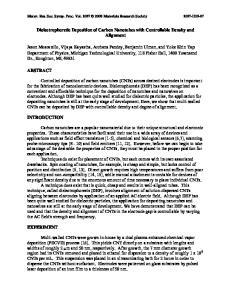Alignment and Deposition of Single Wall Carbon Nanotubes under the Influence of an Electric Field
- PDF / 3,573,794 Bytes
- 6 Pages / 612 x 792 pts (letter) Page_size
- 96 Downloads / 355 Views
NN5.5.1/J8.5.1
Alignment and Deposition of Single Wall Carbon Nanotubes under the Influence of an Electric Field Paul Jaynes, Thomas Tiano, Margaret Roylance and Charles Carey Foster-Miller, Inc. 350 Second Avenue Waltham, MA 02451 Kenneth McElrath Carbon Nanotechnologies, Inc. 16200 Park Row Houston, TX 77084 ABSTRACT Single wall carbon nanotubes have aroused a great deal of interest because of their unique combination of electrical, physical and mechanical properties. However, the widespread use of SWNTs in composites and electronic devices is limited because of the difficulty of dispersing and processing these materials. This paper describes a method for depositing and aligning SWNTs from a dispersed solution onto a substrate under the influence of an electric field. Results indicate that SWNTs can be aligned in bulk in the direction of electric field lines, and that individual SWNT ropes may be deposited between two electrodes. The extent and type of deposition depends upon the electrode geometry and processing time. Electrical alignment of SWNTs is an enabling technology allowing manipulation of nanomaterials using standard processing. It could eventually lead to a wide range of products, such as nanocomposites with aligned fillers and nanoelectronic devices. INTRODUCTION Single-wall carbon nanotubes (SWNTs) have recently aroused a great deal of interest as a new form of carbon. Nanotubes are fullerenes, hollow arrays of carbon atoms bonded in polycyclic aromatic form. A SWNT is, in essence, a single layer of graphite rolled into a seamless tube. The outer diameter of the SWNTs ranges from 0.7 to 3 nm and the tubes can be up to a few microns in length. Their graphitic nature imparts a unique set of electrical physical and mechanical properties that give them extraordinary potential for use in applications ranging from quantum wires to super-strong structures. The ability to manipulate the deposition and alignment of these materials under an electric field would be an enabling processing technology that would potentially allow the fabrication of many much-desired products including nanocomposites with directional conductivity, extremely high tensile strength cables or composites and many electrical devices based on molecular electronics. While SWNTs have excellent electrical [1,2] and mechanical properties, it is only through specialized processing techniques that electrical alignment can be accomplished. Many of the benefits of the extremely small diameter of SWNTs have not been realized because dispersion of SWNTs in solution has proved to be extremely difficult. The nature of the polycyclic aromatic bonds in the Buckytube walls dictates that the electronic structure of these walls is highly polarizable and that these walls are exceedingly smooth on an atomic scale,
NN5.5.2/J8.5.2
allowing adjacent nanotube surfaces to come into close and uniform contact with one another. The combination of smoothness and high polarizability leads to very strong Van der Waals interactions between parallel tubes in contact
Data Loading...











